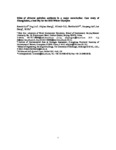Risks of airborne pollution accidents in a major conurbation: case study of Zhangjiakou, a host city for the 2022 Winter Olympics
| dc.contributor.author | Liu, Renzhi | |
| dc.contributor.author | Liu, J | |
| dc.contributor.author | Zhang, Z | |
| dc.contributor.author | Borthwick, Alistair | |
| dc.contributor.author | Cai, Y | |
| dc.contributor.author | Dong, L | |
| dc.contributor.author | Du, X | |
| dc.date.accessioned | 2021-08-22T16:03:03Z | |
| dc.date.available | 2021-08-22T16:03:03Z | |
| dc.date.issued | 2018-11 | |
| dc.identifier.issn | 1436-3240 | |
| dc.identifier.issn | 1436-3259 | |
| dc.identifier.uri | http://hdl.handle.net/10026.1/17689 | |
| dc.description.abstract |
The number of airborne pollution accidents is second only to that of water-borne pollution accidents, in recorded environmental disasters. Acute casualties and public health costs have prompted many airborne pollution risk analyses. To date, few assessment methods have been carried out at regional-scale to quantify acute airborne pollution risk. Herein, a Hybrid Simulation and Risk Analysis approach, involving a systematic combination of simulation, risk ranking, and standardized analysis, is proposed at regional scale. Gaussian and heavy-gas models are utilized in the simulation process, and acute exposure limits preferentially adopted in the risk analysis. The case study shows that 34 of 243 townships in Zhangjiakou City of north China, one of the twin cities selected to host the 2022 Winter Olympics, are threatened by airborne risk sources. It is found that the accidental air pollution risk is comparatively higher in the Xuanhua and Wanquan conurbations. High-risk chemical enterprises (312–432 risk scores) are mostly located near urban areas with high population density where many people are vulnerable receptors to potential air pollution accidents. The resulting risk map indicates that acute airborne pollution from Zhangjiakou would not be a threat either to the proposed Olympic site at Chongli or to downwind Beijing. | |
| dc.format.extent | 3257-3272 | |
| dc.language | en | |
| dc.language.iso | en | |
| dc.publisher | Springer Science and Business Media LLC | |
| dc.subject | Clinical Research | |
| dc.subject | Climate-Related Exposures and Conditions | |
| dc.subject | Prevention | |
| dc.subject | 11 Sustainable Cities and Communities | |
| dc.title | Risks of airborne pollution accidents in a major conurbation: case study of Zhangjiakou, a host city for the 2022 Winter Olympics | |
| dc.type | journal-article | |
| dc.type | Journal Article | |
| plymouth.issue | 11 | |
| plymouth.volume | 32 | |
| plymouth.publication-status | Published | |
| plymouth.journal | Stochastic Environmental Research and Risk Assessment | |
| dc.identifier.doi | 10.1007/s00477-018-1590-5 | |
| plymouth.organisational-group | /Plymouth | |
| plymouth.organisational-group | /Plymouth/Faculty of Science and Engineering | |
| plymouth.organisational-group | /Plymouth/Users by role | |
| plymouth.organisational-group | /Plymouth/Users by role/Academics | |
| dc.identifier.eissn | 1436-3259 | |
| dc.rights.embargoperiod | Not known | |
| rioxxterms.versionofrecord | 10.1007/s00477-018-1590-5 | |
| rioxxterms.licenseref.uri | http://www.rioxx.net/licenses/all-rights-reserved | |
| rioxxterms.type | Journal Article/Review |


